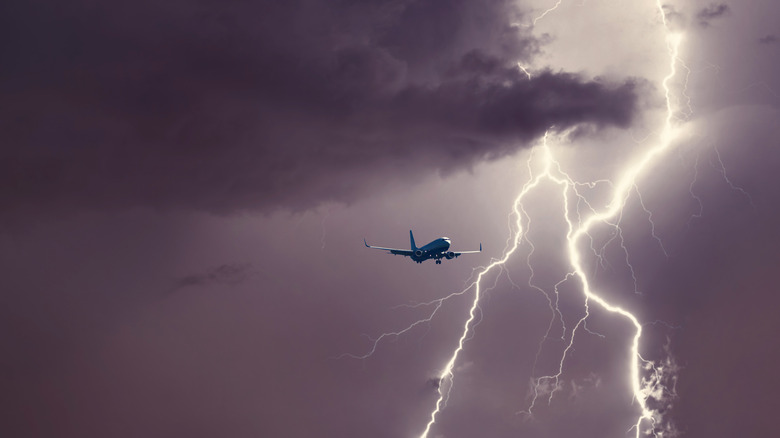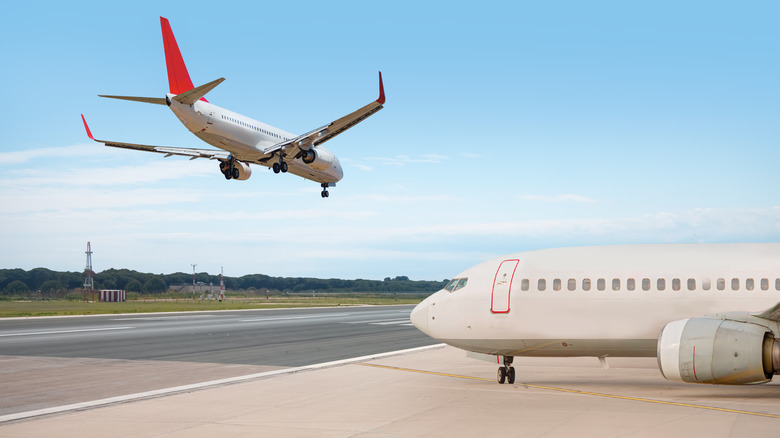The 5 Most Common Plane Problems That Lead To Accidents
With so many high-profile plane crashes in 2025 — in particular the Air India crash of June 12, which left 260 dead — many travelers are nervous about flying and doubtful about how safe flights really are. Doubts about the safety of air travel also have people questioning the reasons for the seemingly frequent accidents. Are flight accidents becoming more commonplace? If so, what causes them?
When you're flying in a tube at 500 mph over 30,000 feet in the air, even small errors can snowball into a problem. So aviation experts, pilots, and regulatory bodies have mapped out scenarios that cover practically every problem an aircraft could face and how to mitigate them. Despite that, flight accidents can occur due to issues like pilot error, mechanical error, or bad weather.
Even though it seems like there are more aviation accidents every year, the truth is that flights are still the safest mode of long-distance travel. Even if you're nervous about flying, the risk of a plane crash is negligible. According to the International Air Transport Association, the average accident-to-total flight ratio in 2024 was 1 flight accident per 880,000 flights. Airlines and air travel authorities are always analyzing flights to determine the exact causes of plane crashes to understand how to make flying safer, and research shows that these are the five most common causes of modern plane crashes.
Pilot error
Ever since air travel became the new way to see the world, several studies have aimed to identify what causes flights to fail. Although accidents typically occur as a result of several things going wrong at once, a 2018 study found that for all aviation accidents that occurred between 1996 and 2015, "deficiency in pilot skills/experience/systems knowledge" was to blame 45% of the time.
Pilot error can take two forms: tactical and operational. Tactical errors include moments when the pilot makes a bad decision that results in an accident, like continuing on a flight path despite poor weather conditions, flying while tired, or taking unnecessary risks like drug or alcohol use. An example of this is the 1994 Aeroflot Flight 593 crash, which occurred because the pilot allowed his teenage son to temporarily take control of the plane. The young man accidentally disengaged the autopilot, resulting in the pilots losing control of the plane. The resulting crash killed the pilot, his children, and all the passengers on board.
Operational errors, on the other hand, typically result from inadequate training and the pilot making mistakes due to a lack of knowledge or experience. Airlines have successfully reduced the number of pilot-driven errors by implementing extensive training policies and hiring more pilots. Mistakes like the 1994 case almost never happen today because of strict policies that prevent unauthorized access to the cockpit.
Mechanical or software failure
Another common reason for plane accidents is mechanical failure. According to research from Embry-Riddle Aeronautical Academy (via Euronews), 21% of plane accidents are caused by a mechanical failure. Most mechanical problems are discovered during pre-flight checks or during scheduled maintenance slots, but sometimes incorrect or inadequate maintenance or inspections can lead to a deadly mechanical failure.
Mechanical failure can result from problems related to the plane's engine, landing gear, critical flight controls, and components. However, scheduled maintenance procedures and required Federal Aviation Administration (FAA) inspections are very thorough, and they usually catch any mechanical issues before a plane ever makes it onto the runway. For this reason, mid-air mechanical issues are rare. Even in severe situations like engine failure, most commercial aircraft are designed to continue flying smoothly even if one engine is damaged.
A primary concern among many air travelers is an airline's or manufacturer's lack of transparency in declaring mechanical or software issues, as in the case of the Boeing 737's recent fatal accidents. In the 2010s, Boeing added a new system to its 737 MAX planes that automatically adjusted the plane's tail to prevent the engines from stalling. But the company left information on this new system out of its training manuals for pilots, and two resulting crashes killed a total of 346 people. Many travelers have been calling out plane manufacturers like Boeing for cutting corners and putting passengers at risk. For example, the 2025 crash of an Air India Boeing 787-8 Dreamliner has been mired in controversy, with some claiming that the dead pilots were blamed because it was more convenient than blaming Boeing or Air India for a mechanical failure. Several of the families of the deceased are suing Boeing and the parts manufacturer Honeywell for negligence.
Weather problems
As you would probably guess, giant flying tubes filled with people are pretty vulnerable to weather conditions. Storms, pollution, wind, and rain can easily turn a routine takeoff or landing into a dangerous event. And because millions of people fly around the world every day, airlines don't always have the luxury of waiting for perfect weather before proceeding with a flight. According to the Federal Aviation Administration (via the BBC), weather is a primary contributing factor in 23% of all plane accidents, both fatal and nonfatal.
Thankfully, airlines routinely plan extensively for bad weather, and it's very rarely the sole reason an airplane crashes. Poor visibility and strong winds are not uncommon during a flight. If you've ever been in a plane, you've probably noticed one of the methods pilots use to avoid rough weather: They move away from the weather system or storm cell. While some routes may experience more turbulence than others because of local weather patterns, many times, pilots can avoid bad weather simply by diverting the flight path or changing altitude. I remember seeing a massive thunderstorm from the plane while I was on vacation earlier this year, and I wasn't worried about lightning striking the plane at any point, because we were several miles above the thunderstorm.
Airlines, air traffic controllers, and meteorologists work together every day to create comprehensive predictions of weather patterns across the world. Flight paths are carefully planned or diverted around bad weather, and pilots are extensively trained to manage tough weather conditions in realistic simulators before they're given their commercial pilot's license.
Air traffic control errors
At any given airport, air traffic controllers (ATC) perform the important job of coordinating incoming and outbound flights, while also coordinating flight paths to avoid mid-air collisions. They also provide important weather updates and guidance during emergencies, like directing planes to nearby airports for emergency landings.
ATC errors only account for a small percentage of flight accidents — around 6% to 10%, according to a 2022 paper published in the International Journal for Traffic and Transport Engineering. Bad judgment calls and simple mistakes like allowing an aircraft to take off while another is due to land or not communicating poor weather conditions are the kinds of errors that air traffic controllers can make. But because ATC plays such a crucial role in flight safety, ATC errors can cause some of the most horrific accidents, like mid-air collisions or runway incursions. For example, at the beginning of 2025, an American Airlines plane and an Army Black Hawk helicopter collided in mid-air over the Potomac in Washington, D.C., leaving no survivors. Air Traffic Control's failure to divert the two away from each other was a major factor in the crash, prompting concern over the state of ATC in the U.S.
Unfortunately, air traffic controllers are struggling due to staff shortages, and what controllers we do still have are overworked in this short-staffed but critical sector of air safety. Most studies that analyzed human error in aviation accidents have already concluded that mental factors like sleepiness, distraction, or fatigue are some of the main causes of human errors, which is why air travel may slow down or face disruptions while the ATC shortage continues. But these factors are much more likely to cause flight delays or cancellations rather than crashes.
Runway incursions and bird strikes
The Federal Aviation Administration's definition of runway incursions is "Any occurrence at an aerodrome involving the incorrect presence of an aircraft, vehicle or person on the protected area of a surface designated for the landing and take off of aircraft." For example, if a plane is getting ready to take off and another one lands right behind it, that counts as a runway incursion. Runway incursions can also include cars or airline employees entering into the path of a plane.
In 2024, 1,757 runway incursions occurred in the U.S. That sounds like a lot until you remember that, across the U.S., there are more than 44,000 flights every day. However, when they do occur, runway incursions can be some of the most terrifying and deadly types of accidents. Take the 1977 Tenerife crash as an example. One flight attempted to take off while the other was still on the runway, resulting in a collision. The subsequent explosion killed 583 people, making it the deadliest commercial plane crash in aviation history.
Bird strikes are also a problem that airports try to regulate. Most bird strikes are harmless (to the plane), but they can cause significant damage if they hit crucial parts of the plane, like the engines or windshield. According to the Telegraph, between 1988 and 2022, 305 aircraft were destroyed by bird strikes, resulting in 464 people losing their lives. To prevent this, airports typically use loud sounds like bullhorns, pyrotechnics, or gunshots to scare nearby birds out of the flight paths.





